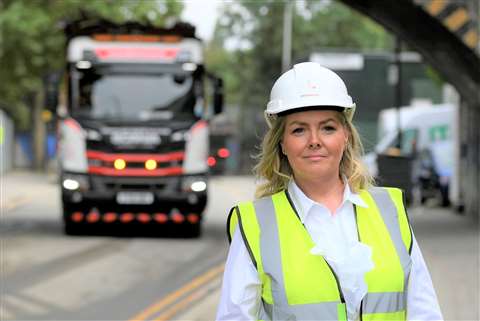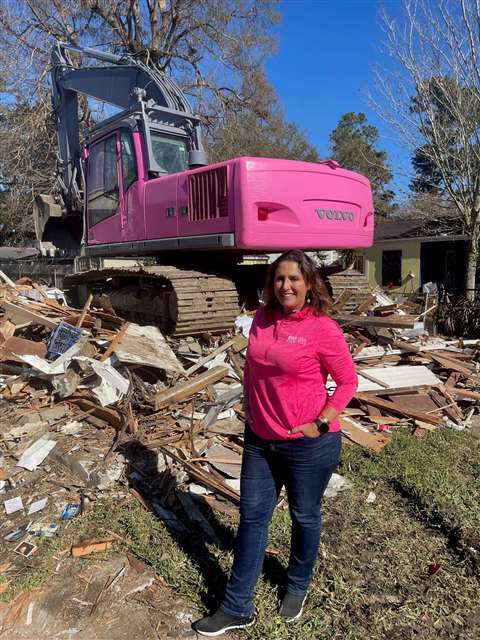Demolishing stereotypes: The women working for gender equality in demolition
08 March 2023
As organisations around the world celebrate International Women’s Day, official figures from around the developed world show that women typically make up less than 15% of the construction workforce and just a tiny proportion of on-site workers. Lucy Barnard speaks to female demolition experts in the US and Europe to find out why and what can be done to improve diversity within the industry.
Jacqueline O’Donovan, managing director of London-based waste management business O’Donovan Waste Disposal, describes the period immediately after she had a baby as the darkest in her career.
Suffering with post-natal depression which left her feeling tearful and unlike herself, O’Donovan, then 31, struggled on without medical help, running the family firm for a few hours a day for four years until the situation resolved itself and she felt more like herself again.
Now, 24 years later, as one of the most recognised female leaders in the United Kingdom’s demolition industry, O’Donovan is keen to use that experience for the good and to support others – especially women in the construction industry.
“Having suffered from something as extreme as the post-natal depression which ultimately ended my marriage and having to still deal with my day-to-day responsibilities, the expectation was that I couldn’t let it interfere with the running of the business,” she says.
 Jacqueline O’Donovan, managing director of London-based waste management business O’Donovan Waste Disposal. Photo: O’Donovan Waste Disposal.
Jacqueline O’Donovan, managing director of London-based waste management business O’Donovan Waste Disposal. Photo: O’Donovan Waste Disposal.
“I personally feel that when issues such as these are tackled head-on, it gives the person suffering the strength and courage to speak openly and freely about how they feel. This then enables work colleagues and businesses to engage and offer support at an early stage which has a far more positive outcome. I’ve also noticed that absenteeism is down when we support employees at an early stage.”
But as O’Donovan prepares to mark International Women’s Day this year, she is aware that she is the exception to the rule and that the construction industry remains one of the most male dominated in the developed world, especially for women with children.
International Women’s Day has been officially marked by the United Nations since the 1970s to both celebrate women’s progress towards gender equality and to highlight the work which still needs to be done.
Since then, much progress has been made, especially in white collar professions. Women now make up almost half of all medical doctors in OECD (Organization for Economic Cooperation and Development) countries. They make up nearly 40% of all lawyers in the USA and 43% of those in Europe. For the first time in history, women make up more than a quarter (28%) of all members of the House of Representatives and the Senate. And, for the first time in 2023, women comprised 10% of CEOs at Fortune 500 companies.
Why does the construction industry employ so few women?
Yet, for the demolition sector and the wider construction industry, progress has been painfully slow. Official figures from around the world show that women typically make up less than 15% of the construction workforce and just a tiny proportion of on-site workers.
Women with blue collar semi-skilled or skilled site-based roles account for only just a tiny fraction of women. According to Statistica, in 2022, just 2.3% of heavy machinery operators, 3.5% of carpenters and 2.9% of brick layers.
And for those in the most senior positions, the data is even more bleak. According to Dutch data company BoldData, just 1% of heavy construction companies have female CEOs while the number of female decision makers at general contractors and installation companies stands at around 1.4%.
“Attracting women into the demolition industry is probably one of the hardest challenges,” O’Donovan says. “A female face on demolition sites is even more rare than on construction sites and so we must continue the charge in supplying separate changing areas and ensuring secure and comfortable working conditions in areas that are predominantly male dominated.”
 Simone Bruni, founder and CEO of New Orleans-based demolition company Demo Diva. Photo: Demo Diva
Simone Bruni, founder and CEO of New Orleans-based demolition company Demo Diva. Photo: Demo Diva
Simone Bruni, founder and CEO of New Orleans, USA-based demolition company Demo Diva agrees.
She says that despite a busy schedule of speaking engagements at local schools and mentoring commitments aimed at encouraging more women into the industry, she only employs two women in her team of 15 and has been unable to recruit a single female on-site worker.
Bruni points out that, on the face of it, the industry has much to recommend it as a relatively highly paid occupation for those without a college degree.
“Every year on careers day I tell these girls that working as a demolition contractor is not only an easy job; it’s not physically demanding, there is no glass ceiling. The whole world is wide open to them,” Bruni says.
“They can make good money, especially if they get into something like asbestos abatement or if they become good managers and can lead a team. And there’s no college fees to pay.
“They can start making money on day one. There is enough work out there for so many more women in the demolition sector but at the moment too few women are applying.”
According to the US Bureau of Labor Statistics, in 2021 construction and trades workers earned a median hourly wage of $23.18 and an annual mean salary of $55,900.
For first line supervisors this rose to a median hourly wage of $34.62 and an annual salary of $75,060. This compares with an overall average median hourly wage across the country of $22 and an annual mean wage of $58,260.
According to salary comparison website Salary Explorer, construction earnings in Europe also remain higher than average, varying from $79,159 in Switzerland and $57,957 in the UK to $41,312 in the Netherlands and $34,270 in France.
In comparison, the average annual salary for nursing assistants in the US, a female dominated entry-level career also entailing long hours, shift work and hard physical labour, stood at $14.56 an hour or $30,290 a year. OECD data for 2020 shows that annual gross salaries for nurses varied between €70,965 in Switzerland, €55,678 in Norway, €22,360 in Greece and €12,172 in Turkey.
The motherhood penalty
For Bruni, the biggest factor preventing women from breaking into the construction industry in greater numbers is the difficulty involved in fitting the work around having a family.
She points out that with day-to-day childcare obligations still disproportionately falling on women around the world, the construction industry offers its workers little by way of flexibility, with difficult commutes, rigid work practices, long hours, an expectation of total availability and a lack of suitable facilities, putting off many workers, especially those with families from entering the industry.
“Childcare is the number one factor holding women back in the construction industry,” says Bruni.
“Even the vice president of my company is struggling with this problem now because in her role she needs to attend a 7 am safety briefing and it’s hard to combine that with childcare. If you’re working on site it’s even harder. On a demolition site for example it’s hard to stop in the middle of a job and get clean so that you can pump breastmilk.”
Academics Christine Wall and Linda Clarke go further, linking the current situation with a systematic exclusion of women from the construction trades before the 1970s and a system of subcontracting out work which leads to informal recruitment processes that favours men.
 Waterloo Bridge in London was built during World War II by a predominently female construction team. Photo: Adobe Stock
Waterloo Bridge in London was built during World War II by a predominently female construction team. Photo: Adobe Stock
They point out that during the Second World War, women’s participation in the construction industry in both the USA and the UK increased significantly as men were required to fight on the front line and women recruited to take their places.
According to UK government figures, the number of women employed in the industry increased from 15,700 in 1939 to 24,200 by 1945.
However, hostility from trade unions, many of whom refused to accept women trainees meant that many of these skilled women workers were forced out of the industry after the war ended.
And yet they argue it is a lack of state regulation over training within the construction industry and a dwindling number of recognised apprenticeship schemes which have become the key factors preventing women from entering the industry.
“Labour-only subcontracting and what is known as bogus self-employment have become entrenched; major contractors no longer employ directly but subcontract everything out, and only about half of the private sector workforce is directly employed,” they write.
“The result has been to deter the social development of labour, to fossilise any training around the old training divisions and to enforce trade sectarianism, so reducing even further the opportunities for women to be employed and reinforcing their exclusion at the point of entry.”
And, they say, not only has this left construction firms struggling to appoint women to their ranks, but it has also left them struggling to recruit men in sufficient numbers too.
The construction skills shortage
In November 2021, the European Labour Authority identified construction as one of four groups of occupations with the greatest skills shortages in the EU and in February 2023 the US contractors trade body Associated Builders and Contractors (ABC) reported that the construction industry will need to attract an estimated 546,000 additional workers on top of the normal pace of hiring in 2023 to meet the demand for labour in the US.
“With nearly one in four construction workers older than 55, retirements will continue to whittle away at the retirement workforce,” says ABC chief economist Anirban Basu. “The number of construction labourers, the most entry level occupational title, has accounted for nearly four out of every 10 new construction workers since 2012. Meanwhile the number of skilled workers has grown at a much slower pace.”
Bruni believes that the growing skills shortage in construction, coupled with increasing pressure from employees, investors and customers, is forcing employers to diversify their workforces.
She points out that a shortage of skilled workers in the construction industry in both Europe and the US has become so severe that private companies are now sponsoring promising high school students, both male and female, to commit to internships in order to boost intakes.
Sanna Lepistö is the quality and environmental manager of Finish site decontamination and demolition specialist Insinööritoimisto Lepistö. As the only woman with a senior role in a company of twelve, she says that it is important for more women to put themselves forward as role models within the industry in order to encourage others.
 Sanna Lepistö, quality and environmental manager of Finish site decontamination and demolition specialist Insinööritoimisto Lepistö. Photo: Insinööritoimisto Lepistö
Sanna Lepistö, quality and environmental manager of Finish site decontamination and demolition specialist Insinööritoimisto Lepistö. Photo: Insinööritoimisto Lepistö
Lepistö says that although awareness days like International Women’s Day leave themselves open to criticism that they are being exploited by social media managers as little more than a marketing exercise, while ignoring the wider issues causing gender inequality, celebrating women’s success within the industry is nonetheless important.
“More women should be seen speaking at seminars, summits and different organizations to give courage to other women,” she says. “We do not want to use this special day for marketing, and I believe that when we are paying attention in the right way, we do not undermine the meaning of it.”
Connie Clearwater, marketing director at Canadian demolition firm, Priestly Demolition, agrees.
“Every year on International Women’s Day we like to do a feature video highlighting the incredible women we have working in various roles within our organisation,” she says.
“From field workers to rock truck drivers, lead hands, torchers to project co-ordinators, managers, estimators and paralegals. We have women employed in virtually all areas. We want to share these experiences with other young women who may be thinking of entering the construction and demolition industry.
“These powerful testimonials share the true experiences of working in what was traditionally thought of as a man’s world. This video and short reel are shared on all of our media platforms.”
Moreover, there are some indications that things are set to improve over time. If changes in working patterns implemented during the pandemic are implemented on a wide scale, they could provide all workers with a better work-life balance and provide more flexibility for those with caring responsibilities. And, eventuially, advances in technology could fundamentally change the nature of onsite construction, leaving much of the physically hard and dirty work to robots.
Clearwater says that she has already noticed attitudes towards women changing within her company over the last decade.
“We are a collective of strong and powerful women and enjoy the opportunity to celebrate our success,” she says. “The stereotype does not exist as it did ten years ago, not in our place of business anyway. The old stereotypes are dying off and we see fathers and daughters working side-by-side which is an amazing thing.”
Jacqueline O’Donovan, London, UK
Jacqueline O’Donovan left school at 16 with O-levels in maths, art and child development intending to work as a nanny in Germany before getting married and having a family. But just as she was preparing to leave, her father Joe died suddenly, leaving his wife and children to carry on the business as best they could. Initially looking after her mother, she began to spend days with her three older siblings scaling down and running her father’s business. Soon that morphed to become a six-day work week with O’Donovan taking night courses on road haulage and waste management to plug the gaps in her knowledge. Three years later, at the age of 19, she officially took on the role of managing director. And since then, the company has grown beyond recognition. Under O’Donovan’s leadership the business has grown its turnover from £175,000 (US$ 207,120) in 1990 to £17.76 million ($21 million) in 2022. At the same time the company’s workforce which stood at 12 in 1988 had grown to over 100 last year when it was acquired by Swedish firm Sortera.
Simone Bruni, New Orleans, USA
Like O’Donovan, Bruni only ended up in the demolition industry as a result of personal tragedy, this time hurricane Katrina, which devastated her home city of New Orleans in 2005, flooding her house and leaving her jobless after she was laid off as an events planner. “The city was shut down and everyone was evacuated except heavy equipment,” Bruni says. “For me, it really came from a place of compassion. I thought what skills have I got to bring the city back? There were people coming in from all across America bringing heavy equipment to help with the clean-up. As a woman in that situation, I was scared and didn’t know what to do. So, I started out, initially as a broker for other demolition contractors, selling trust to my neighbours. I only bought my own equipment and started my own demolition business later.” Since then Bruni has buit up a formidable business employing a team of 15 and known across the city for its striking pink excavators and dumpsters.
Sanna Lepistö, Lahti, Finland
Sanna Lepistö has worked as a consultant in the environmental and industrial field since 2009. She has an MSc in chemical technology and a civil engineering qualification. She is also a certified asbestos and hazardous substances professional in Finland and a certified environmental sampler. Her work is mostly on demolition projects as well as contaminated soil investigations and remediation. Demolition projects consist of planning, pre-demolition surveys such as asbestos and contaminated soil surveys, inviting tenders and supervising the contracts.
STAY CONNECTED



Receive the information you need when you need it through our world-leading magazines, newsletters and daily briefings.
CONNECT WITH THE TEAM










